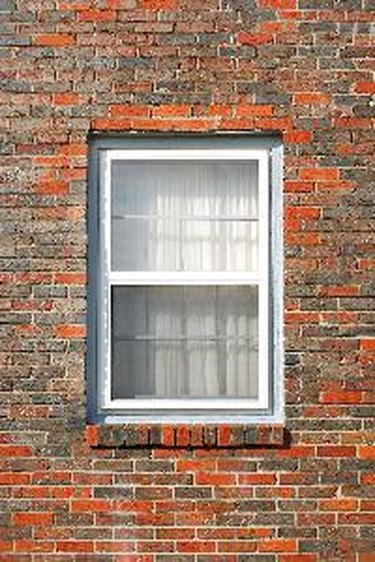
Moisture content and differences in climate can shift soil beneath a home's foundation. When foundation shifting occurs, windows often fall out of alignment with the window frames. Misalignment is one reason why a window won't close or lock. Caulking also can protect a window from issues that eventually lead to sticking.
Shifting Foundation
Video of the Day
A shifting foundation, especially a concrete slab foundation, is a primary cause of sticking windows. When a house shifts, pressure is exerted onto window frames. This forces the frames out of alignment. A distorted frame will cause window sash channels (the tracks where a window slides) to no longer line up with the window, preventing it from fully opening or closing. Most window locks also are based on a rocking or sliding mechanism that requires two sections to align in order to connect and lock. Try lifting or pushing on the window slightly, while simultaneously attempting to shut the window. Then, lift or push on the area of the window around the lock, while simultaneously trying to lock the window. Foundation repair might be necessary to resolve windows that stick.
Video of the Day
Warped Wood
Worn caulk around a window eliminates the waterproof seal that protects the frame and walls of the window from moisture and stops air leaks. Moisture accumulating on a wood frame will cause paint to crack and allow water to penetrate the wood. Absorbed moisture causes the window frame to swell and puts pressure on the window so it cannot close, open or subsequently lock. The wood dries through evaporation, but the window might remain distorted and prohibit it from aligning with the lock mechanism. If the frame is badly warped, the window must be replaced. Removing old caulking and re-caulking the window can prevent future moisture buildup from affecting the window's movement.
Obstructions
Shabby window screens or debris accumulated in the window track blocks the window path. Metal locks also can erode because of condensation, causing the metal to rust. Rusty or rough patches on the lock also might prohibit it from locking. Rust also might accumulate on the metal portions of window tracks. Use a dry soap bar, a wax candle or block, household lubricant spray or furniture polish/dusting spray to lubricate window tracks. Wiggle the window up and down to work the lubrication into all areas of the track. Continue lubricating until you are able to push the window shut.
Damaged Frame or Window
When a window or frame sustains extensive damage, it might require replacement. Remove the original window and frame and install a new one. If you don't have these repair skills, it is best to leave window replacement to professionals. Refer to your home warranty to see whether these costs will be covered.